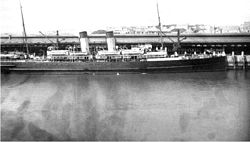HMHS Anglia
|
||||||||||||||||||||
|
||||||||||||||||||||
|
||||||||||||||||||||
The Anglia was a British passenger steamer of the London and North Western Railway that was put into service in 1900 and was used as a ferry in the Irish Sea . During the First World War , the ship served as a hospital ship until it ran and sank on November 17, 1915 near Folkestone on a sea mine laid by the German submarine UC 5 . 134 crew members and members of the medical staff were killed.
history
The 1,862 GRT steel steamship Anglia was built with the hull number 619 at the shipyard William Denny and Brothers in the Scottish city of Dumbarton and was launched on December 20, 1899. On April 10, 1900, the ship was completed and on May 2, 1900 it first arrived in Holyhead . The Anglia was 100.3 meters long and 11.9 meters wide. It had two chimneys, two masts and two propellers . The triple expansion steam engines made 424 nominal horsepower (nhp) and allowed a top speed of 21 knots (39 km / h).
The ship was built for the London and North Western Railway (LNWR), for which it was initially used in the ferry service from Holyhead to North Wall, a district of Dublin and from 1908 from Holyhead to Kingstown . She had an identical sister ship , the Hibernia (hull number 618, 1,862 GRT), which was also built by William Denny and was launched two days after the Anglia .
Sinking
After the outbreak of the First World War, the Anglia was converted into a hospital ship. On Wednesday, November 17, 1915, the Anglia was sailing from Calais to Dover with 13 wounded officers and 372 wounded soldiers under the command of Captain Lionel John Manning . In addition, 56 crew members and medical personnel, such as doctors and nurses, were on board the ship.
At around 12.30 p.m. on November 17, the Anglia ran a mile east of the port city of Folkestone on the coast of Kent County at position 51 ° 2 ′ N , 1 ° 19 ′ E on a sea mine , which was operated by the German submarine UC 5 ( Oberleutnant zur See Herbert Pustkuchen) had been placed.
The steamer was hit on the port side . The force of the explosion threw Captain Manning off the bridge . Nevertheless, he retained his senses and immediately ordered the ship to be abandoned. The first lifeboat was able to leave the sinking ship with around 50 people. After that, took Anglia increasingly heavy blow side and sank ten minutes after the mines.
The torpedo cruiser Hazard and the Collier Lusitania came to the aid of the struck ship. The Lusitania itself was hit by a mine and sank. Your team was able to save itself. Of the people aboard the Anglia , four officers, a nurse and 129 wounded and crew members were killed. Twelve days earlier, on November 5, 1915, the sister ship Hibernia , which had been renamed Tara , was sunk by a German submarine. U 35 (Korvettenkapitän Waldemar Kophamel ) torpedoed the Tara in the Gulf of Sallum (Egypt), whereby twelve people were killed.
See also
- Dover Castle : British hospital ship; sunk by a German submarine on May 26, 1917 (7 dead)
- Britannic : British hospital ship; ran into a German sea mine on November 21, 1916 and sank (30 dead)
- Salta : British hospital ship; ran into a German sea mine on April 10, 1917 and sank (130 dead)
- Glenart Castle : British hospital ship; sunk by a German submarine on February 26, 1918 (153 dead)
- Llandovery Castle : British hospital ship; sunk by a German submarine on June 27, 1918 (234 dead)



